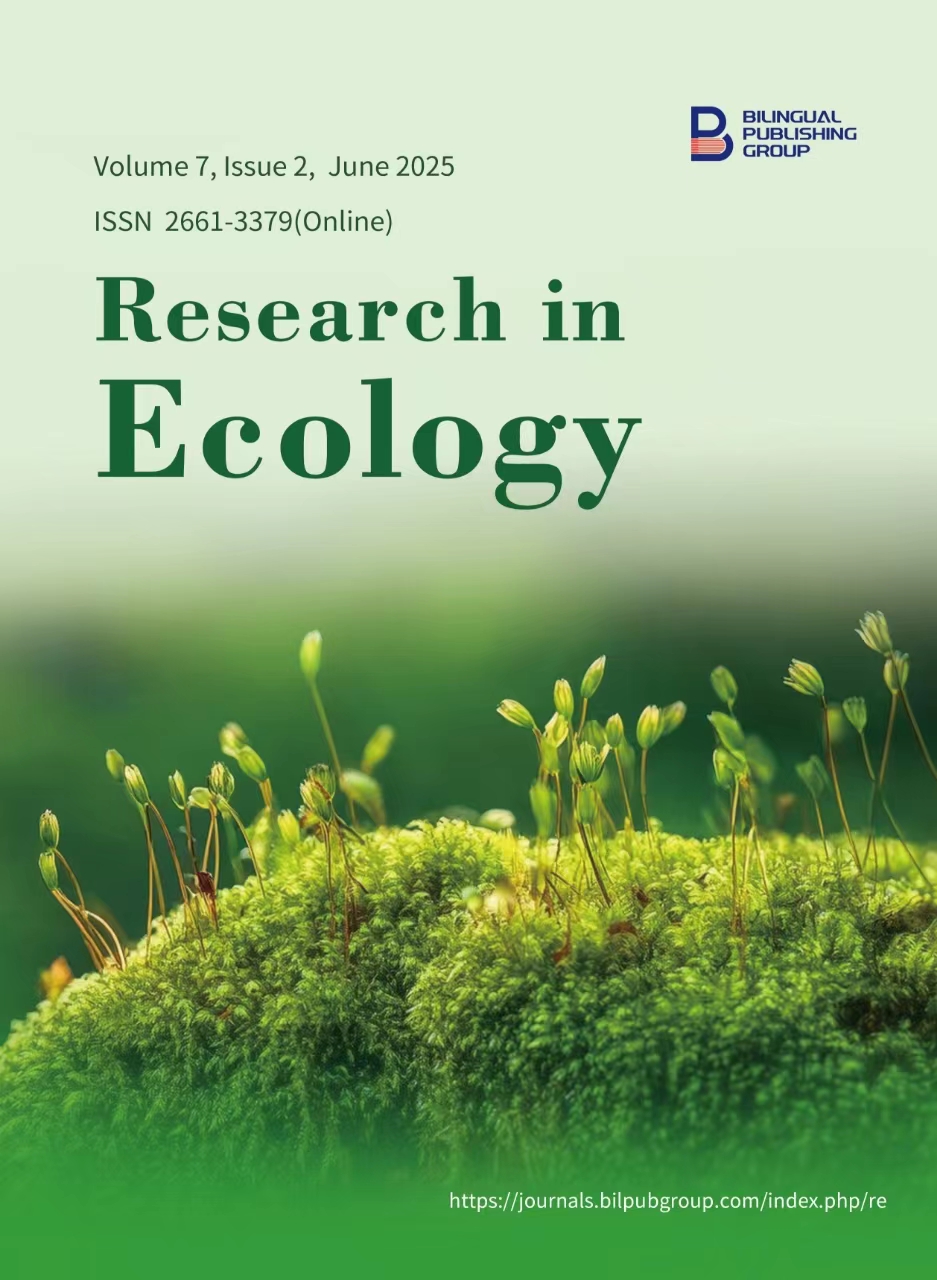
Molecular and Toxicological Characterization of Indigenous Bacillus thuringiensis for Eco-Biocontrol of Spodoptera frugiperda in Corn Agroecosystems
DOI:
https://doi.org/10.30564/re.v7i2.10102Abstract
This study investigated the eco-biocontrol potential of indigenous isolates obtained from agricultural soils in Warbo Village, Papua, Indonesia, targeting the highly destructive fall armyworm (Spodoptera frugiperda) in corn agroecosystems. A total of 58 bacterial colonies were isolated, of which 18 were morphologically confirmed as Bacillus thuringiensis based on endospore and parasporal crystal protein characteristics. These isolates were cultured in Tryptose Phosphate Broth and tested for larvicidal activity against second-instar larvae under controlled conditions. Toxicity tests revealed that isolate 18 exhibited the highest efficacy, causing 100% larval mortality, followed by isolates 12 and 13 with 93.3%, confirming a strong entomopathogenic potential. The most toxic isolates were further verified by the presence of cry1F and cry2Aa genes through PCR analysis, indicating the molecular basis of their virulence. The innovation of this research lies in the combination of morphological, toxicological, and molecular characterizations of locally adapted Bacillus thuringiensis strains, which offers a sustainable, environmentally friendly alternative to chemical pesticides. These findings provide a scientific foundation for developing region-specific bioinsecticides, reducing dependence on synthetic inputs, and supporting sustainable pest management strategies in tropical corn production systems.
Keywords:
Bacillus thuringiensis; Soil; Plantation; Toxicity; Larvae; Fall ArmywormReferences
[1] Kassogué, A., Dıcko, A., Traoré, D., et al. 2016. Bacillus thuringiensis strains isolated from agricultural soils in mali tested for their potentiality on plant growth promoting traits. British Microbiology Research Journal . 14(3), 1–7.
[2] Karuppaiyan, T., Balasubramani, V., Murugan, M., et al. 2022. Characterization and evaluation of indigenous bacillus thuringiensis isolate t352 against fall armyworm, spodoptera frugiperda (j.e. Smith). International Journal of Plant & Soil Science. 729–736.
[3] Nanlohy, H.Y., Wardana, I.N.G., Hamidi, N., et al. 2018. The effect of Rh3+ catalyst on the combustion characteristics of crude vegetable oil droplets. Fuel. 220.
[4] Huang, M., Wang, J., Wang, B., et al. 2020. Optimizing sowing window and cultivar choice can boost china’s maize yield under 1.5 °C and 2 °C global warming. Environmental Research Letters. 15(2), 24015.
[5] Ashpreet, K.R., Reji, A.P., 2024. Socio-economic profile of the farmers and effect of multimedia on their knowledge enhancement of maize. International Journal of Agriculture Extension and Social Development. 7(4), 111–119.
[6] Doshi, M.N., Badr, K., Ejaz, M., et al. 2024. Investigation of novel bacteriocin producers of Bacillus thuringiensis and partial characterization of two new bacteriocins: Thuricin 466 and thuricin 4Q7. Bioresource Technolgy Reports. 25, 101760.
[7] Kumar, R.M., Gowda, G.B., Paramesh, V., et al. 2022. Sustainable management of invasive fall armyworm, spodoptera frugiperda. Agronomy. 12(9), 2150.
[8] Goergen, G., Kuma,r P.L., Sankung, S.B., et al. 2016. First Report of Outbreaks of the Fall Armyworm Spodoptera Frugiperda (J E Smith) (Lepidoptera, Noctuidae), a New Alien Invasive Pest in West and Central Africa. PLoS ONE. 11(10), e0165632.
[9] Tay, W.T., Meaghe,r R.L., Czepak, C., et al. 2023. Spodoptera frugiperda: Ecology, evolution, and management options of an invasive species. Annual Review of Entomology. 68(1), 299–317.
[10] Mamahit, J.M.E., Kolondam, B.J., 2023. A review on fall armyworm (spodoptera frugiperda) insecticide resistance. International Journal of Research and Review. 10(5), 146–151.
[11] Prabhu, D.I.G., Vennison, S.J., Vasan, P.T., et al. 2018. Genetic characterization of native bacillus thuringiensis strains isolated from Tamil Nadu, India. Bioscience Biotechnology Research Communication. 11(4), 587–594.
[12] Sathish, S., Supriya, S., Andal, P., et al. 2022. Effective utilization of azolla filiculoides for biodiesel generation using graphene oxide nano catalyst derived from agro-waste. Fuel. 329, 125412.
[13] Ramos, Y., Taibo, A.D., Jiménez, J.A., et al. 2020. Endophytic establishment of beauveria bassiana and metarhizium anisopliae in maize plants and its effect against spodoptera frugiperda (J. E. Smith) (Lepidoptera: Noctuidae) Larvae. gyptian Journal of Biological Pest Control. 30(1).
[14] Herlinda, S., Gustianingtyas, M., Suwandi, S., et al. 2022. Endophytic fungi from south sumatra (indonesia) in seed-treated corn suppressing spodoptera frugiperda growth. Biodiversitas Journal of Biological Diversity. 23(11).
[15] Mantzoukas, S., Eliopoulos, P.A., 2020. Endophytic Entomopathogenic Fungi: A Valuable Biological Control Tool Against Plant Pests. Applied Sciences. 10(1), 360.
[16] Abbas, A., Ullah, F., Hafeez, M., et al. 2022. Biological Control of Fall Armyworm, Spodoptera Frugiperda. Agronomy. 12(11), 2704.
[17] López-Castillo, L.M., Silva-Fernández, S.E., Winkler, R., et al. 2018. Postharvest Insect Resistance in Maize. Journal of Stored Products Research. 77, 66–76.
[18] Rajagopal, R., Swaminathan, S., Agrawal, N., et al. 2002. Silencing of Midgut Aminopeptidase N of Spodoptera Litura by Double-Stranded RNA Establishes Its Role asBacillus Thuringiensis Toxin Receptor. Journal of Biological Chemistry. 277(49), 46849–46851.
[19] Pardo‐López, L., Soberón, M., Bravo, A., 2013. Bacillus Thuringiensis insecticidal Three-Domain Cry Toxins: Mode of Action, Insect Resistance and Consequences for Crop Protection. Fems Microbiology Reviews. 37(1), 3–22.
[20] Broadhead, G.T., Liu, H., Sumrall, G.L., et al., 2024. Volatile Byproducts of Carotenoid Degradation as Biomarkers of Maize Infestation by the Maize Weevil (Sitophilus Zeamais) (Motsch.). Journal of Agricultural and Food Chemistry. 73(3), 1835–1843.
[21] Lantang, D., Runtuboi, D.Y., 2018. Karakterisasi Bakteri Bacillus Thuringiensis Asal Hutan Lindung Kampus Uncen Jayapura, Serta Deteksi Toksisitasnya Terhadap Larva Nyamuk Anopheles. Journal of Integrative Plant Biology. 4(1), 19–24.
[22] Katsaruware-Chapoto, R.D., Mafongoya, P., Gubba, A., 2017. Responses of Insect Pests and Plant Diseases to Changing and Variable Climate: A Review. Journal of Agricultural Science. 9(12), 160.
[23] Nuambote-Yobila, O., Bruce, A.Y., Okuku, G.O., et al., 2023. Assessment of Resistance Mechanisms to Fall Armyworm, Spodoptera Frugiperda in Tropical Maize Inbred Lines. Agronomy. 13(1), 203.
[24] Timilsena, B.P., Niassy, S., Kimathi, E., et al., 2021. Potential Distribution of Fall Armyworm in Africa and Beyond, Considering Climate Change and Irrigation Patterns.
[25] Maheesha, M., Balasubramani, V., Murugan, M., et al., 2022. Characterisation of Native ≪i>Bacillus Thuringiensis< I> Isolates Toxicity to Fall Armyworm, ≪i>Spodoptera Frugiperda< I> (J.E. Smith). Biological Control. 171–180.
[26] Mc, N., Mohan M, Basavaarya., et al., 2020. Entomopathogenic Screening of Native Bacillus Thuringiensis (Berliner) Isolates Against Spodoptera Frugiperda (Smith) (Lepidoptera: Noctuidae) Under Laboratory Condition. International Journal of Chemical Studies. 8(6), 2340–2344.
[27] Deutsch, C., Tewksbury, J.J., Tigchelaar, M., et al. 2018. Increase in Crop Losses to Insect Pests in a Warming Climate. Science . 361(6405), 916–919.
[28] Dimitriadis, K.A., Koursaros, D., Savva, C.S., 2024. Evaluating the sophisticated digital assets and cryptocurrencies capacities of substituting international currencies in inflationary eras. International Review of Financial Analysis. 96, 103693.
[29] Sales, C.R., Farinacio, R., Chicoma Rojas, L.A., et al. 2025. Enterococcus mundtii (JBC60 isolate) in the control of the fall armyworm: A new biocontrol possibility. Biological Control. 203,105710.
[30] Nashwa, A.H.F., Aziza, A., 2023. Effectiveness of Teflubenzuron, Emamectin Benzoate, and Alfa-Cypermethrin on Fall Armyworm, Spodoptera Frugiperda (J.E Smith) (Noctuidae: Lepidoptera), Under Laboratory and Field Conditions. Egyptian Academic Journal of Biological Sciences. A, Entomology. 16(1), 133–139.
[31] Fiaboe, K.R., Fening, K.O., Gbewonyo, W.S.K., et al., 2023. Bionomic Responses of Spodoptera Frugiperda (J. E. Smith) to Lethal and Sublethal Concentrations of Selected Insecticides. PLoS ONE 18(11), e0290390.
[32] Guo, Z., Gong, L., Kang, S., et al., 2020. Comprehensive analysis of Cry1Ac protoxin activation mediated by midgut proteases in susceptible and resistant Plutella xylostella (L.). Pesticide Biochemistry and Physiology. 163,23–30.
[33] Yang, Y.J., Xu, H.X., Wu, Z.H., et al., 2021. Effects of inhibitors on the protease profiles and degradation of activated Cry toxins in larval midgut juices of Cnaphalocrocis medinalis (Lepidoptera: Pyralidae). Journal of Integrative Agriculture. 20(8), 2195–2203.
[34] Abdelmalek, N., Sellami, S., Kallassy-Awad, M., et al., 2017. Influence of Ephestia kuehniella stage larvae on the potency of Bacillus thuringiensis Cry1Aa delta-endotoxin. Pesticide Biochemistry and Physiology. 137, 91–97.
[35] Hang, P.L.B., Linh, N.N., Ha, N.H., et al., 2021. Genome sequence of a Vietnamese Bacillus thuringiensis strain TH19 reveals two potential insecticidal crystal proteins against Etiella zinckenella larvae. Biological Control. 152.
[36] Zanchi, C., Sofia Lindeza, A., Kurtz, J., 2020. Comparative mortality and adaptation of a smurf assay in two species of tenebrionid beetles exposed to bacillus thuringiensis. Insects. 11(4).
[37] Gharsallah, H., Ksentini, I., Abdelhedi, N., et al., 2019. Screening of bacterial isolates related to olive orchard pests in Tunisia using 16S ribosomal RNA and evaluation of their biotechnological potential. Journal of Applied Microbiology. 126(2), 489–502.
[38] Singh, V.K., Phanindra, M.L.V., Nain, V., et al., 2022. Targeting delta-endotoxin (Cry1Ac) of Bacillus thuringiensis to subcellular compartments increases the protein expression, stability, and biological activity. International Journal of Biological Macromolecules. 205, 185–192.
[39] Kumar, R., Shanker, R., Singh, P., et al., 2024. Genome editing towards pests and disease management in agricultural crops: Recent developments, challenges and future prospects. Physiological and Molecular Plant Pathology. 134, 102402.
[40] Raj, N., Shukla, H., Agarwal, P., et al., 2024. Rapid transfer of the leaf rust resistance gene Lr52 for the improvement of bread wheat cultivar HD3086. Physiological and Molecular Plant Pathology. 134.
[41] Sabbahi, R., Hock, V., Azzaoui, K., et al., 2022. A global perspective of entomopathogens as microbial biocontrol agents of insect pests. Journal of Agriculture and Food Research. 10, 100376.
[42] Kim, E., Kim, J.Y., Kim, W., et al., 2023. Complete genome sequence of an oryctes rhinoceros nudivirus isolated from Korean rhinoceros beetles (Trypoxylus dichotomus) in Korea. Virus Research. 335, 199167.
[43] Tabein, S., Nazarpour, D., Hegazy, A., et al., 2025. Diverse viral communities inhabit the guts of date palm rhinoceros beetles (Oryctes spp.). Journal of Invertebrate Pathology . 211, 108321.
[44] Sathyan, T., Jayakanthan, M., Mohankumar, S., et al., 2022. Genome profiling of an indigenous Bacillus thuringiensis isolate, T405 toxic against the fall armyworm, Spodoptera frugiperda (J.E. Smith) (Lepidoptera: Noctuidae). Microbial Pathogenesis. 173, 105820.
[45] Cornejo, C., Hauser, A., Beenken, L., et al., 2021. Cryphonectria carpinicola sp. nov. Associated with hornbeam decline in Europe. Fungal Biology. 125(5), 347–356.
[46] Marisel, O.G., Yoania, R.R., Lily, X., et al., 2024. Bioprospecting a mountain-derived phosphorus-solubilizing bacterium: Bacillus thuringiensis B3 as a plant-growth promoter in lettuce and tomato horticultural crops. Scientia Horticulturae. 337, 113568.
[47] Xie, M., Zhong, Y., Lin, L., et al., 2025. Comprehensive transcriptome and metabolome analysis of the adaptability and detoxification ability of Spodoptera frugiperda larvae to tobacco. Journal of Insect Physiology.163, 104800.
[48] Martínez, E., Riquelme Virgala, M.B., Dettler, M.A., et al., 2025. Autodissemination of insecticides applied to agricultural pests: Spodoptera frugiperda’s role in generating toxicity on its offspring. Crop Protection. 194, 107238.
[49] Deng, F., Zhang, Y., Chen, Y., et al., 2025. Genome-wide identification and expression analysis of the BBX gene family in Lagerstroemia indica grown under light stress. International Journal of Biological Macromolecules. 297, 139899.
[50] Eski, A., Demir, İ., Güllü, M., et al., 2018. Biodiversity and pathogenicity of bacteria associated with the gut microbiota of beet armyworm, Spodoptera exigua Hübner (Lepidoptera: Noctuidae). Microbial Pathogenesis. 121, 350–358.
[51] Jaffar, S., Ahmad, S., Lu, Y., 2022. Contribution of insect gut microbiota and their associated enzymes in insect physiology and biodegradation of pesticides. Front Microbiol. 14,13.
[52] Shahmohammadi, N., Esmaeily, M., Abdisa, E., et al., 2024. Enhanced baculoviral virulence by suppressing the degradation of an insect immune resolvin, epoxyoctadecamonoenoic acid, in three lepidopteran insects. Journal of Invertebrate Pathology. 204, 108095.
[53] Niu, J., Wang, C., Liao, M., et al., 2025. Supramolecular self-assembly of emamectin benzoate with β-cyclodextrin and polylactic acid: Enhancing pesticide efficacy and environmental safety. Chemical Engineering Journal. 2509, 160834.
[54] Obayori, O.S., Ashade, A.O., Salam, L.B., et al., 2024. Heavily polluted mechanic workshop soil and its phenanthrene-degrading Bacillus thuringiensis. The Microbe. 4, 100104.
[55] Cai, Y., Hou, B., Fabrick, J.A., et al., 2025. The role of aquaporins in osmotic cell lysis induced by Bacillus thuringiensis Cry1Ac toxin in Helicoverpa armigera. Pesticide Biochemistry and Physiology. 204,106068.
[56] Liu, L., He, W., Xu, P., et al., 2024. Contribution of the transcription factor SfGATAe to Bt Cry toxin resistance in Spodoptera frugiperda through reduction of ABCC2 expression. International Journal of Biological Macromolecules. 267, 131459.
Downloads
How to Cite
Issue
Article Type
License
Copyright © 2025 Daniel Lantang, Rosye H. R. Tanjung, Daawia Suhartawan, Ester Rampa, Hendry Y. Nanlohy

This is an open access article under the Creative Commons Attribution-NonCommercial 4.0 International (CC BY-NC 4.0) License.




 Daniel Lantang
Daniel Lantang






